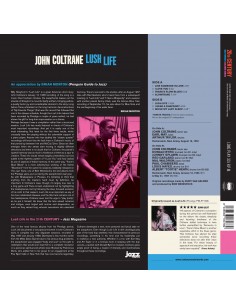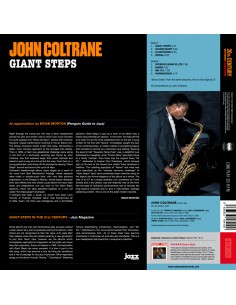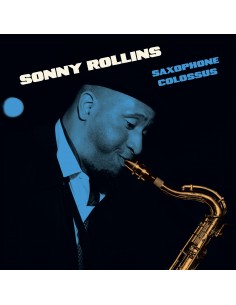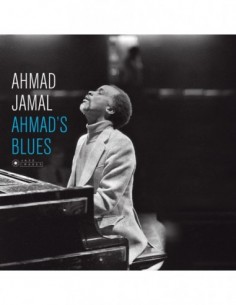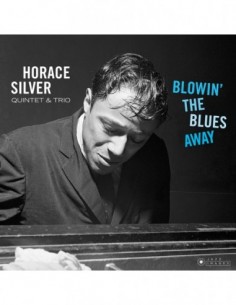Cookin'
Miles Davis· THE FRANCIS WOLFF COLLECTION
· DELUXE GATEFOLD SLEEVE
· 180-gram pure virgin vinyl LP in Gatefold packaging
· IMAGES BY ICONIC JAZZ PHOTOGRAPHER FRANCIS WOLF
· 5 DOWNBEAT MAGAZINE
· INCLUDES 2 BONUS TRACKS
Miles Davis’ first classic quintet was formed in 1955 and is widely regarded as one of the greatest combos in jazz history. Cookin’ was the first in a series of four albums featuring the group recorded between May and October of 1956. The program presents some tunes the quintet had been playing live, along with others that appear to have been improvised on the spot and which had never been previously recorded. Sonny Rollins’ “Airegin” had been recorded by Miles with Milt Jackson and Rollins on June 29, 1954, for the album Bags’ Groove. Credited to Miles and Red Garland, “Blues by Five” is most likely a blues createdon the spot. Cookin’ contains the earliest existing version of Miles performing “My Funny Valentine”, asong popularized in jazz by Chet Baker, and which Miles would maintain in his repertoire until at least 1966. Two tunes from the first Prestige LP by the quintet have been added as a bonus.
PERSONNEL:
- MILES DAVIS, trumpet
- JOHN COLTRANE, tenor saxophone
- RED GARLAND, piano
- PAUL CHAMBERS, bass
- PHILLY JOE JONES, drums
Hackensack, New Jersey, October 26, 1956.
- (*) BONUS TRACKS:
- Same personnel. Hackensack, New Jersey, November 16, 1955.
- From the LP The New Miles Davis Quintet (Prestige LP7014).
SIDE A:
- 1 MY FUNNY VALENTINE
- 2 BLUES BY FIVE
- 3 JUST SQUEEZE ME (*)
SIDE B
- 1 AIREGIN
- 2 TUNE UP
- 3 WHEN LIGHTS ARE LOW
- 4 S’POSIN’ (*)
- Format
- LP
- Discs
- 1
- Label code
- 37146

Miles Davis
Miles Davis, trumpeter and composer, undoubtedly shares the worldwide recognition that jazz history grants to other musicians such as Charlie Parker, John Coltrane and Louis Armstrong.
He is one of the most influential jazz figures of the second half of the last century, a product of his constant search for innovation, including extraordinary fusions with rock.
His place on the podium of any jazz lover is well deserved, as he represents one of the most important jazz avant-garde of all times. He has been nominated for 4 Grammy Awards and other important awards such as the American Book Award, the Paul Ackett Award and the Léonie Sonning Music Award.
Want to know more about this great artist? Read on to learn about his life and work!
BIOGRAPHY
Miles Davis was born in Alton, Illinois, on May 25, 1926, and died in Santa Monica on September 28, 1991. Shortly after Miles was born, the family moved to East St. Louis, where Miles' father established a successful dental practice.
While life for most of the African American community during the 1920s was difficult, Miles and his siblings lived comfortably. Miles' parents were college graduates, which allowed them to live in an upper-class neighborhood. His mother, Cleota Mae, was a music teacher, so Miles' interest in music emerged at an early age. When he was 13, he fell in love with jazz music and began taking trumpet lessons from a local musician named Elwood Buchanan.
Miles received the opportunity of a lifetime when he was selected to fill in for an ailing trumpet player in Billy Eckstine's orchestra. There, Miles played with some of the founders of bebop, including Dizzy Gillespie, Charlie Parker and vocalist Sarah Vaughn. Davis was especially attracted to Charlie Parker, whose style of playing included improvisational solos.
As soon as he moved to New York, Miles set out to find Charlie Parker. It took him several days, but he finally ran into Parker at a local nightclub. The two became fast friends, and even moved into an apartment together. Spending time with Charlie helped Miles perfect his playing, and he was chosen to record some sessions with Parker and Dizzy Gillespie. After a few months, Miles left the Juilliard School to pursue a career as a jazz player.
He began playing with the Charlie Parker Quintet, alongside jazz greats such as Parker and Max Roach. In 1947, he had the opportunity to write original songs for the Eckstine group, composing four original tunes of his own.
Later, he managed to put together his own quintet, with talented musicians such as saxophonist John Coltrane and drummer Philly Joe Jones. The group recorded four albums in 1956, including "Cookin' with the Miles Davis Quintet" and "Relaxin' with the Miles Davis Quintet". In 1958, Miles formed a slightly different group with a sixth member, and the sextet recorded the album "Miles Davis Milestones".
MUSICAL INFLUENCES
While many artists of his generation learned to play music by ear, Miles Davis learned the finer points of music theory and sheet music. His great knowledge of melody and arrangement allowed him to play almost any song with any performer. By the time he was in high school, he was already sitting in with some of the local jazz greats during live shows.
But his main musical influence came from Charlie Parker, who was his friend and mentor, with whom he discovered the very essence of innovation. Rock, no doubt, is also part of this influence and that can be seen in his most brilliant fusions, as well as in bebop, cool, hard bop and avant-garde styles in their modal side.
COLLABORATORS IN PERFORMANCE
Miles worked with other jazz virtuosos such as Herbie Hancock, pianist Chick Corea, composer Quincy Jones and bassist Marcus Miller. In the 1980s, Miles re-emerged with another sound, featuring synthesizers and song samples. His album "Miles Davis Tutu" won a Grammy Award in 1987, the fourth of his career.
He was able to share the stage with stars and personalities such as Charlie Parker, Dizzy Gillespie, Benny Carter, John Lewis, Nelson Boyd, Max Roach, as well as renowned jazzmen John Lewis, Gerry Mulligan, Kai Winding, Kenny Clarke, Lee Konitz and J. J. Johnson. Also recording with him at some of the most important moments of his career were John Coltrane, Jimmy Cobb, Paul Chambers, Bill Evans, Wynton Kelly and Cannonball Adderley.
DISCOGRAPHY
Miles' greatest recording achievement would come in 1959, when the Miles Davis Quintet completed the album "Kind of Blue". Featuring classical pianist Bill Evans, "Kind of Blue" had a completely different sound, with a new type of experimental jazz called modal jazz. The album would become not only Miles' best-selling album, but the best-selling jazz album of all time. Here is a summary of his essential repertoire:
Miles Davis - Birth of the Cool (1957)
L'ascenseur pour l'échafaud (1958)
Milestones (1958)
Kind of Blue (1959)
Porgy and Bess (1959)
Sketches of Spain (1960)
In a Silent Way (1969)
Bitches Brew (1970)
A tribute to Jack Johnson (1971)
You're under arrest (1985)
As an interesting fact: in 2009, the US Congress unanimously recognized the album "Kind of Blue" as an American treasure.
MOST FAMOUS SONG
"Birth of the cool", together with the album "Kind of Blue", are undoubtedly Miles Davis' most iconic productions. There is also the Miles Davis song "Miles Ahead", created just after he left his drug addiction. Another of Miles Davis' iconic tracks is "Blue in green", a milestone in the modal style and the third song on the album "Kind of Blue".
ONE OF THE IDOLS OF THE GENRE
In addition to being a brilliant and avant-garde musician, it is enough to look up the artistic works of Miles Davis to find out that he was also an excellent painter of his own album covers. His career left an unprecedented musical legacy, especially at a time when important jazz personalities were also building their own legacies. He influenced generations and marked important milestones that took jazz to other levels of interpretation.
 Cookie preferences
Cookie preferences































